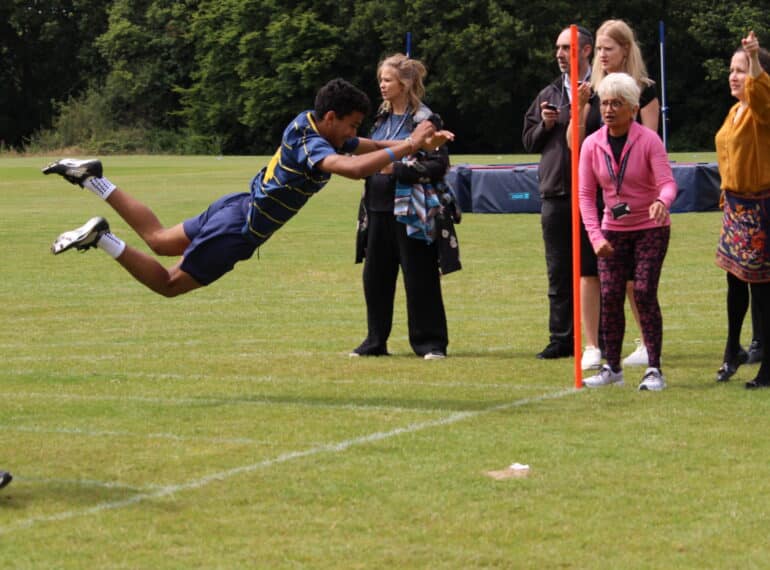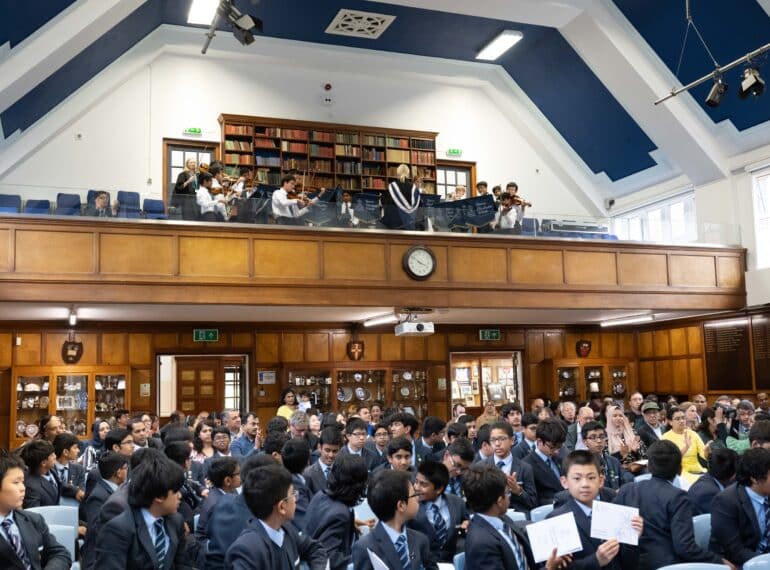
Founder’s Day 2025 drew large numbers of visitors for the afternoon fete, who helped smash a £25,000 fundraising target.
The day, a traditional highlight of QE’s calendar, began with a service at St John the Baptist Church. That was followed by the formal Roll Call and Reading of the School Chronicle in front of QE’s Main Building.
Then it was time for the Friends of Queen Elizabeth’s Fete to begin on Stapylton Field, where visitors could enjoy dozens of attractions, ranging from a plants stall and coconut shy through to barbecues and tents offering cuisine from around the world.
Headmaster Neil Enright: “Founder’s Day 2025 was a tremendous day from start to finish. The fete was very enjoyable, with great food and diverse cultural entertainment on the stage. Even the weather seemed to be on our side: although it was a hot day, we were blessed with a little cloud and even some (unforecast) light rain – it all helped keep everyone cool.”
“I am extremely pleased to be able to report that we have raised £40,904.50 – and still rising! That is a magnificent sum significantly exceeding both this year’s £25,000 target and the amount raised last year. My thanks to everyone who gave generously.”
“I congratulate and thank all those involved in making Founder’s Day 2025 such a terrific success – especially the FQE Fete Committee, who have spent countless hours organising the fete over many months, and their small army of parent volunteers who turned out on the day. I should also mention our prefect team, who also worked tirelessly throughout the day.”
The service at the parish church featured a selection of hymns and readings, as well as music from the School Choir, Junior Barbershop Group and three young organists – Arthur Wang, Year 7; Gabriel Ward, Year 8; and Zach Fernandes, of Year 9.
The guest speaker was 2015 School Captain Norbert Sobolak. He spoke powerfully to the Year 7 boys in the congregation, reminding them of the achievements of Old Elizabethans Demis Hassabis (1988–1990) and Mustafa Suleyman (1995–2002). The pair were among the three co-founders of leading AI company, DeepMind, while last year, Sir Demis won a Nobel prize for Chemistry.
“Dream so big it scares you,” Norbert said. “Build your own path, even when the world says no. Never, ever give up. And I promise you: you will not just change your life; you will change the world.”
After the service, the staff, dressed in academicals, made their way to the School with the rest of the congregation for the lunchtime Roll Call and Reading of the School Chronicle (a history of notable events in the School’s history) in front of Main Building.
The fete was well attended. The programme includes more details about the event, as well as articles and advertisements from the fete’s supporters.
Among the most popular attractions was the bowl-at-a-teacher stall, making use of the cricket cage. As well as music from QE ensembles, there were colourful displays of dancing on the stage, while the Main School Hall housed an archival display that included QE’s founding charter of 1573.
Among those who enjoyed the chance to examine the charter were representatives of the QE Global Schools programme, from Global Education (GEDU), who attended the celebrations and supported the day.
As well as takings on the day, the fundraising total was boosted by the sale of advertising, by giving online, and by sponsored House competitions held by both the Music and PE departments.
Funds raised will be put towards the complete refurbishment of two Biology laboratories, helping QE to respond effectively to the growing demand for subject-specific science laboratories as the numbers taking A-level sciences has risen in recent years. There is still time to donate: the dedicated Founder’s Day JustGiving page remains open.
- Click the thumbnails below to view the images.

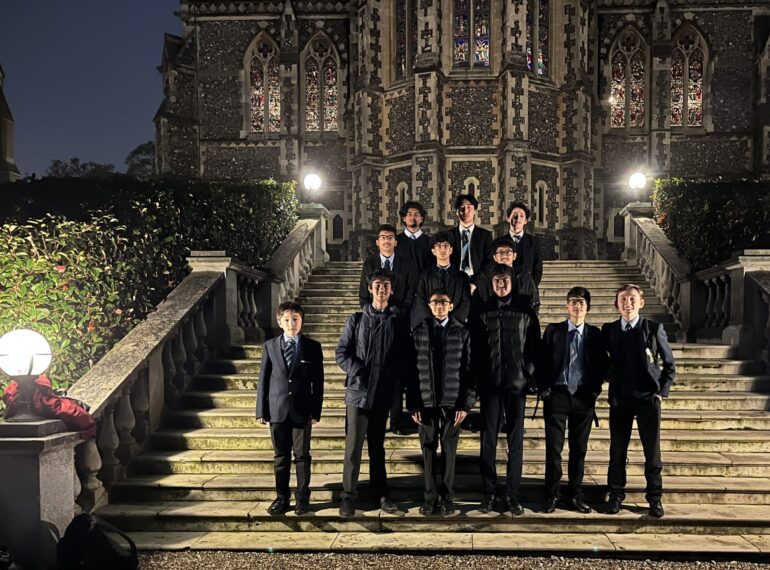
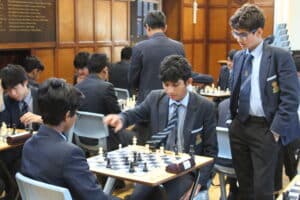 The successes capped a term in which no fewer than 168 boys took part in in-School tournaments for Years 9, 10 & 11.
The successes capped a term in which no fewer than 168 boys took part in in-School tournaments for Years 9, 10 & 11.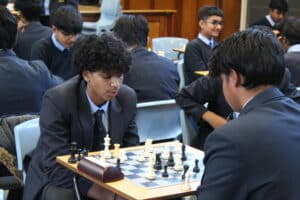 Eighteen teams took part in the regional qualifier.
Eighteen teams took part in the regional qualifier.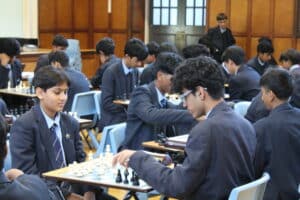 Joshua John, Year 13
Joshua John, Year 13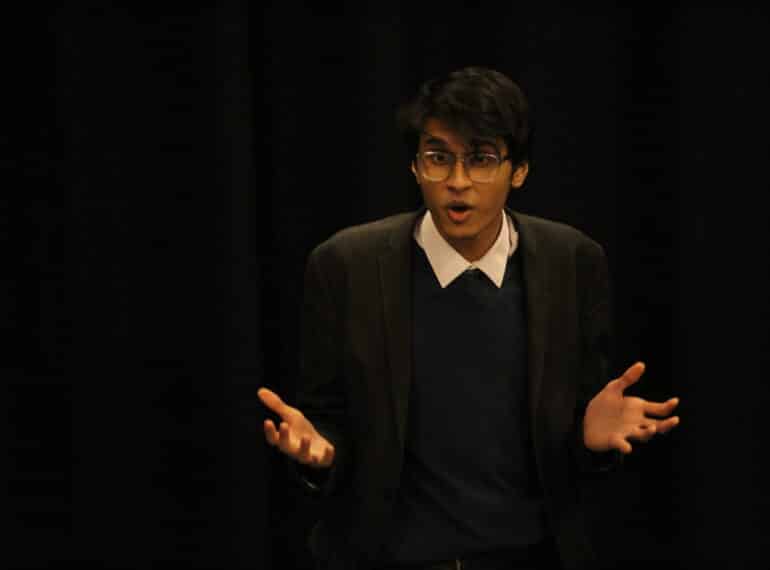
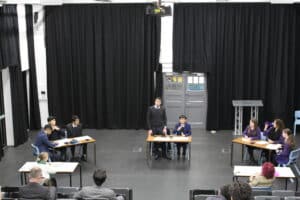 The studio, created from two existing large rooms towards the rear of the Main Building, hosted early rounds of the English Speaking Union’s Schools’ Mace debating contest and of the national Performing Shakespeare competition.
The studio, created from two existing large rooms towards the rear of the Main Building, hosted early rounds of the English Speaking Union’s Schools’ Mace debating contest and of the national Performing Shakespeare competition.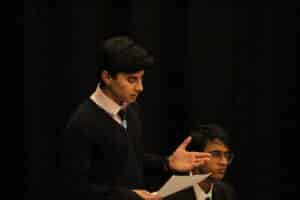 At the Mace, the country’s oldest and largest debating competition for schools, a senior QE team – including School Captain Chanakya Seetharam, as well as Zaki Mustafa, and Koustuv Bhowmick, all from Year 13 – took on Haberdashers’ Girls’ School. Other leading schools from North London and Hertfordshire also competed. The QE team won the event to progress to the second-round heats in January.
At the Mace, the country’s oldest and largest debating competition for schools, a senior QE team – including School Captain Chanakya Seetharam, as well as Zaki Mustafa, and Koustuv Bhowmick, all from Year 13 – took on Haberdashers’ Girls’ School. Other leading schools from North London and Hertfordshire also competed. The QE team won the event to progress to the second-round heats in January.  Head of English Robert Hyland said: “There are some things which reading Shakespeare simply as words on the page can never give – so much of the impact of his work comes from how performers have chosen to interpret, following the rhythms and the imagery of the poetry to bring the words to life.
Head of English Robert Hyland said: “There are some things which reading Shakespeare simply as words on the page can never give – so much of the impact of his work comes from how performers have chosen to interpret, following the rhythms and the imagery of the poetry to bring the words to life.  The special English lesson held in RDS also focused on Shakespeare, looking at scene 3 from act 3 of
The special English lesson held in RDS also focused on Shakespeare, looking at scene 3 from act 3 of  “We subsequently returned to the language, thinking about the delivery of the speech which Ariel gives, and what key or words ideas come to light when presented dramatically.”
“We subsequently returned to the language, thinking about the delivery of the speech which Ariel gives, and what key or words ideas come to light when presented dramatically.” 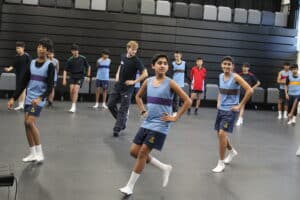 ENB dancers and a musician later came to QE and gave the boys a two-hour contemporary ballet workshop, testing the RDS’s audio equipment to the full. They explored ways of moving, inspired by the plot, characters and choreography of
ENB dancers and a musician later came to QE and gave the boys a two-hour contemporary ballet workshop, testing the RDS’s audio equipment to the full. They explored ways of moving, inspired by the plot, characters and choreography of 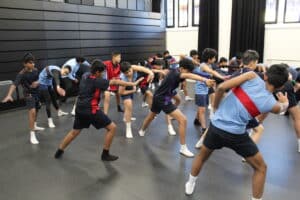 “Best of all though was the enthusiasm and energy the boys put into their dancing. Who knows – maybe the next Akram Khan has just learnt his first dance steps?
“Best of all though was the enthusiasm and energy the boys put into their dancing. Who knows – maybe the next Akram Khan has just learnt his first dance steps?
 “My congratulations go to House Captain Robin Bickers, Deputy House Captain Zeyuan Wu, and to all the members of Broughton House,” he said. “As the points totals attest, this was a closely fought contest. Points are amassed from many different areas of School life, and Broughton’s achievement thus demonstrates considerable commitment, as well as consistency across a broad range of endeavour.”
“My congratulations go to House Captain Robin Bickers, Deputy House Captain Zeyuan Wu, and to all the members of Broughton House,” he said. “As the points totals attest, this was a closely fought contest. Points are amassed from many different areas of School life, and Broughton’s achievement thus demonstrates considerable commitment, as well as consistency across a broad range of endeavour.” He told the boys that QE Flourish this year included no fewer than 200 trips, 33 of them residential. Every single member of QE’s teaching staff took part in at least one School trip. Six hundred and fifty boys had seen a live show. In total, the programme had delivered 13,508 experiences to individual pupils, Mr Bonham-Carter said.
He told the boys that QE Flourish this year included no fewer than 200 trips, 33 of them residential. Every single member of QE’s teaching staff took part in at least one School trip. Six hundred and fifty boys had seen a live show. In total, the programme had delivered 13,508 experiences to individual pupils, Mr Bonham-Carter said. The assembly also celebrated a busy year for the School’s musicians, who have been involved in eight concerts, QE’s May the fourth be almost with you Music festival, trips, charity performances, and this month’s tour to Vienna, as well as providing musical support for several formal School occasions.
The assembly also celebrated a busy year for the School’s musicians, who have been involved in eight concerts, QE’s May the fourth be almost with you Music festival, trips, charity performances, and this month’s tour to Vienna, as well as providing musical support for several formal School occasions.